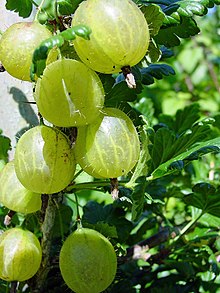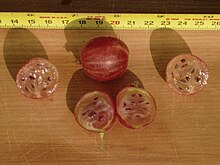| Gooseberry | |
|---|---|
 | |
| Cultivated Eurasian gooseberry | |
| Scientific classification | |
| Kingdom: | Plantae |
| (unranked): | Angiosperms |
| (unranked): | Eudicots |
| (unranked): | Core eudicots |
| Order: | Saxifragales |
| Family: | Grossulariaceae |
| Genus: | Ribes |
| Species: | R. uva-crispa |
| Binomial name | |
| Ribes uva-crispa L. | |
Although usually placed as a subgenus within Ribes, a few taxonomists treat Grossularia as a separate genus, although hybrids between gooseberry and blackcurrant (e.g., the Jostaberry) are possible. The subgenus Grossularia differs somewhat from currants, chiefly in their spiny stems, and in that their flowers grow one to three together on short stems, not in racemes.
Gooseberry bushes produce an edible fruit and are grown on both a commercial and domestic basis.
Contents |
Growth habit and physical characteristics
The gooseberry is a straggling bush growing to 1–3 metres (3–10 feet) tall, the branches being thickly set with sharp spines, standing out singly or in diverging tufts of two or three from the bases of the short spurs or lateral leaf shoots. The bell-shaped flowers are produced, singly or in pairs, from the groups of rounded, deeply-crenated 3 or 5 lobed leaves. The fruit of wild gooseberries is smaller than in the cultivated varieties, but is often of good flavour; it is generally hairy, but in one variety smooth, constituting the R. uva-crispa of writers; berries' colour is usually green, but there are red variants and occasionally deep purple berries occur.Range
The gooseberry is indigenous in Europe and western Asia, growing naturally in alpine thickets and rocky woods in the lower country, from France eastward, well into the Himalayas and peninsular India.
Currant and gooseberry output in 2005
William Turner describes the gooseberry in his Herball, written about the middle of the 16th century, and a few years later it is mentioned in one of Thomas Tusser's quaint rhymes as an ordinary object of garden culture. Improved varieties were probably first raised by the skilful gardeners of Holland, whose name for the fruit, Kruisbezie, may have been easily corrupted into the present English vernacular word. Towards the end of the 18th century the gooseberry became a favourite object of cottage-horticulture, especially in Lancashire, where the working cotton-spinners have raised numerous varieties from seed, their efforts having been chiefly directed to increasing the size of the fruit.
Climate
Of the many hundred varieties enumerated in recent horticultural works, few perhaps equal in flavour some of the older denizens of the fruit-garden, such as the old rough red and hairy amber. The climate of the British Isles seems peculiarly adapted to bring the gooseberry to perfection,[citation needed] and it may be grown successfully even in the most northern parts of Scotland where it is commonly known as a "grozet"; indeed, the flavour of the fruit is said to improve with increasing latitude. In Norway (where it's named "stikkelsbær" — or "prickly berry"), the bush flourishes in gardens on the west coast nearly up to the Arctic circle, and it is found wild as far north as 63°. The dry summers of the French and German plains are less suited to it, though it is grown in some hilly districts with tolerable success. The gooseberry in the south of England will grow well in cool situations, and may be sometimes seen in gardens near London flourishing under the partial shade of apple trees; but in the north it needs full exposure to the sun to bring the fruit to perfection. It will succeed in almost any soil, but prefers a rich loam or black alluvium, and, though naturally a plant of rather dry places, will do well in moist land, if drained.It is also widely found in villages throughout the former Czechoslovakia.
Cultivation
The easiest method of propagating gooseberries is by cuttings rather than raising from seed;cuttings planted in the autumn will take root quickly and can begin to bear fruit within a few years.Vigorous pruning may be necessary; fruit is produced on lateral spurs and the previous year's shoots, so the 19th-century custom was to trim side branches in the winter, and perhaps trim leading shoots at that time or remove their tips in the summer.
Large berries can be produced by heavy composting, especially if the majority of the fruit is picked off while small to allow room for a few berries to continue to grow. Grafting of gooseberry vines onto ornamental golden currants (Ribes aurum) or other Ribes species can be helpful for this purpose. Some 19th- and early 20th-century cultivators produced single gooseberries near to two ounces in weight, but, as with many varieties of fruit, larger sizes of gooseberry proved to have weaker flavor.

Ribes uva-crispa[2]
Pests
Gooseberry bushes are vulnerable to magpie moth (Abraxas grossulariata) caterpillars. In cultivation, the best method for removing them is to remove the larvae by hand soon after they hatch; its eggs are laid on fallen gooseberry leaves.Other potential threats are V-moth (Macaria wauaria) and Gooseberry sawfly (Nematus ribesii). Nematus reibesii grubs will bury themselves in the ground to pupate; on hatching into adult form, they lay their eggs, which soon hatch into larvae, on the underside of gooseberry leaves. 19th-century insecticides against these included tar water, weak solutions of carbolic acid, and powdered hellebore, which worked against magpie moths and V-moths as well as gooseberry sawflies. (Foxglove and tobacco infusions were also sometimes used.) Careful removal of fallen leaves and tilling of the ground around the plant will also destroy most eggs and chrysalises of these insects.
Potassium sulfide was known to be an effective treatment for blights and other parasitic growths, such as American gooseberry mildew.
Note that like most Ribes, the gooseberry is a potential host for white pine blister rust, which can cause serious damage to white pines; thus, gooseberry cultivation is illegal in some areas of the U.S.






No comments:
Post a Comment